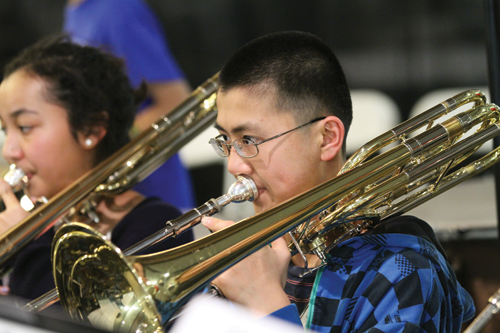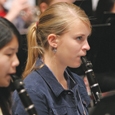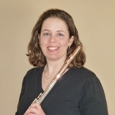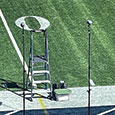
While flute is a common beginning instrument, there are many reasons people learn flute after studying another instrument. Saxophonists, for example, often pick up flute as a secondary instrument to become more versatile for jazz, and music education majors learn flute as part of their curriculum. Unlike true beginners, these musicians come to the flute with musical knowledge, but their experience learning a different instrument can create misunderstandings or areas that will need more attention. The difficulties will vary based on which instrument the student played previously. Awareness of these differences will help teachers more effectively and efficiently introduce flute to these students.
Reed Instruments
Clarinetists and saxophonists frequently use an eee vowel shape while playing, while flutists rarely, if ever, use such a high tongue position. For clarinetists and saxophonists, the high tongue position helps create a sort of laser beam of air that is focused toward the opening between the mouthpiece and reed. Because the high tongue position is so common on those instruments, students more familiar with playing clarinet or saxophone often revert to that position on flute, which negatively affects their tone. Teachers can hear this when the sound either cuts in and out while playing, a sign that the tongue is getting in the way, or when the tone is extremely airy, yet the aperture and embouchure appear correct from the outside. A good fix for too high of a tongue position is to tell students to make the tongue like a carpet on the bottom of the mouth, ensuring that it is spread out and flat. Sometimes, thinking of a very open throat, like one is swallowing an egg whole, can help students find the correct low tongue position and open mouth shape. Thinking of creating space between the back teeth, as if baby carrots were lying between the upper and lower molars, can also help.
The process of articulating also differs between reed instruments and the flute. Reed players articulate by touching the tip of the tongue to the tip of the reed. As a result, they often find the concept of articulating without touching a reed very different. Teachers should clearly explain how to articulate on the flute, whether advocating tonguing behind the teeth on the roof of the mouth or using forward-tonguing, and not assume that students will already know how to do this. Be very specific about which part of the tongue touches which part of the inside of the mouth. Sometimes, students will create all sorts of odd methods of tonguing if the procedure is not clearly explained, including sticking the tongue the whole way out through the lips, articulating with the throat, and even articulating by stopping the air between each note.
When clarinetists want to produce a warmer-sounding tone, they think of using cold air and vice versa. This is the opposite of how these sounds are produced on flute. Remind clarinetists of this when exploring tone colors or striving for a warm sound. Flutists frequently play with a warm tone, and clarinetists often struggle to produce such a tone. This can be practiced by noticing the difference between blowing cold air, as one would do to cool soup, and blowing warm air, as one would do to steam up a window.
The way pitch is affected by range and dynamics is also opposite on reed instruments. Generally, when reed players play loudly, they become flat, while flutists tend to become sharp. The same is often true when playing higher. Where flutists tend to play flat in the lower register and sharp in the high register, reed instruments tend to have opposite intonation tendencies. Reed players who are playing flute often default to applying the pitch tendencies of their original instrument. Working with a buddy and a tuner to check the pitch of the notes in the chromatic scale can help clarify which notes are sharp or flat on flute.
Finally, flexibility and the sort of pursing of the lips that are essential for forming flute tone differ from the lip shape for playing reed instruments. Saxophonists and clarinetists roll the lower lip under slightly to play, and oboists and bassoonists roll both lips in slightly to cushion the reed. Flutists do not roll their lips under at all to play. Teachers should use exercises that help students explore the flexibility of the lips. One strategy to help with rolling the lips out slightly is to light a candle and have students bend the flame without blowing out the candle. Another strategy is to remind the student that the air needs to pass over the smooth, inner surface of the lips, not the part of the lips where one would apply lip balm. Teachers should also model the shape of the lips in front of a mirror and have students imitate the position.
Brass
For brass players, the major concern is this same flexibility and lip shape for flute tone. Brass musicians, especially high brass players, often tend to hold the lips rather firmly against the teeth and do not purse the lips out at all. They may even very slightly roll them in before buzzing (like saying em). Use the same strategies mentioned previously for reed players to solve this.
Brass players use either a slide or three or four valves and overtones or partials to produce all of the pitches on their instruments. When moving to the flute, these musicians may struggle to coordinate the right and left hands working together to produce notes. Have them practice by isolating two notes that are problematic and moving very slowly between them. They should gradually increase speed, being careful that all fingers are moving precisely together. Additional finger independence exercises, like those in the first exercises in Trevor Wye’s Practice Book for the Flute Book 6: Advanced Practice, will help them isolate and strengthen specific fingers and practice moving cleanly among a variety of notes.
When teaching slurring, teachers should bear in mind that trombonists do not slur on trombone the way flutists do. Because of the slide, trombonists tongue all of their notes, even if they appear under a slur, unless a slide is specified. They use a lighter legato tonguing, but that does not transfer to slurring on flute. Explain and practice the technique of not moving the tongue at all as they move between slurred notes. Trombonists may need to be reminded to slur without lightly articulating because they are accustomed to doing this when they see slurs.
Everyone Else: Percussion, Keyboard, Strings, Voice
Most students coming to flute struggle to provide a small enough aperture to make a focused sound. While this is true of students coming from reed or brass instruments, it is especially a problem for students who have never made an embouchure. Teachers should be prepared with multiple ways to teach the small aperture required for playing flute. Use a mirror and model just how tiny the aperture should be. Another option is to place cotton balls on a music stand and have the flutist blow the air so that only one cotton ball moves. If multiple cotton balls move, the aperture is too big and unfocused. Using tangible and visible strategies to make the aperture smaller are better than wordy descriptions.
There is usually a discrepancy between students’ abilities to navigate fingerings and read music and the endurance and flexibility of their embouchure muscles. These muscles often begin to quiver while playing as fatigue sets in. Encourage them to practice in gradually increasing intervals to build endurance. During lessons, alternate between playing and other activities, like discussing the form of the piece, music history, theory, or other aspects of pedagogy, so they can play without fatigue.
Percussionists, string players, and pianists may be new to the concept of breathing to play an instrument and will need to start with the basics as they learn to play the flute. Vocalists can apply breathing techniques that are part of healthy singing to playing the flute.
General Difficulties
The asymmetrical position of the flute on the right side of the body is problematic for most people switching to the instrument. Spend time clearly explaining how to hold the instrument as well as posture, and hand position Be consistent in enforcing proper positioning to avoid injury. Students should practice in front of a mirror and to watch for raised shoulders, awkwardly positioned wrists, and incorrect neck position (neck sticking out like a turtle, for example). They should also make sure that the body is at a 45-degree angle to the stand, and the flute is parallel to the stand. Students’ arms may tire easily until muscles are built up to support this correct positioning, so they will need frequent breaks and stretching.
Teaching flute to students who play a different instrument can be extremely rewarding. Generally, they are very motivated and have chosen to learn the instrument for the sake of being able to play flute or for the opportunities it will provide, such as being a more versatile jazz musician or a more effective band director. Having a basic knowledge of the common differences between flute and other instruments will help teachers guide these students more effectively.






